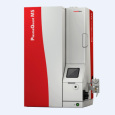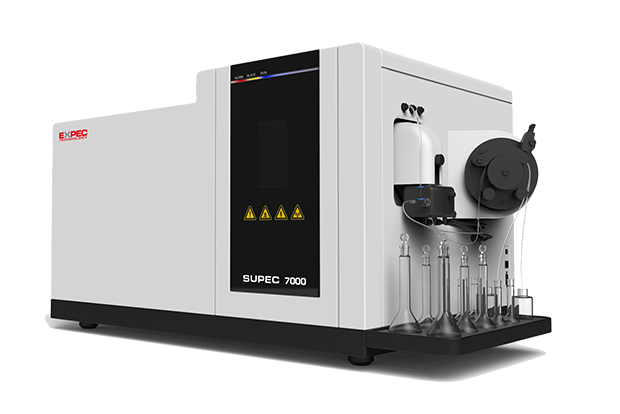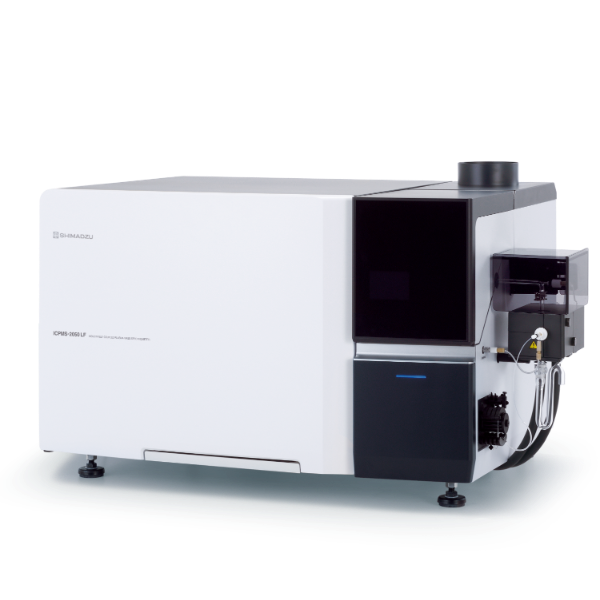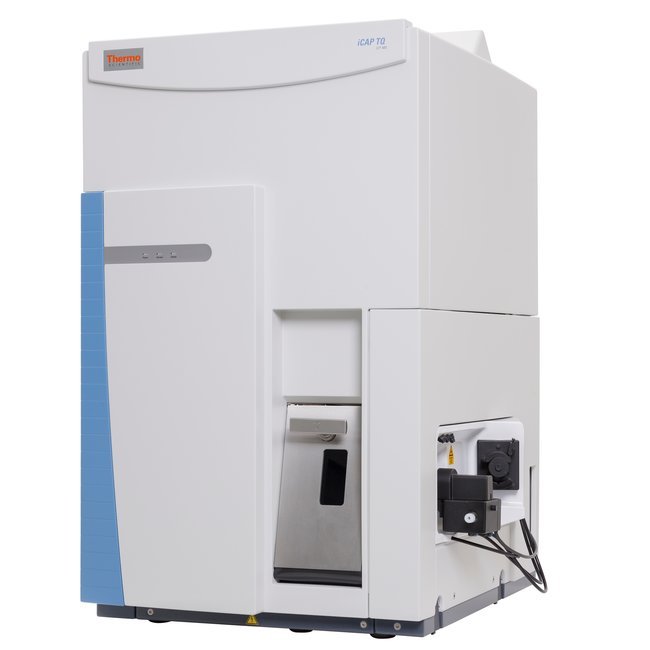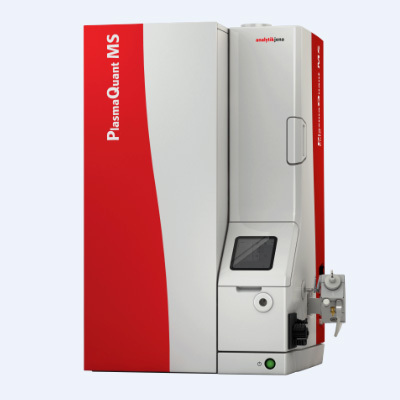
方案详情
文
铍摄入量较高时会导致一些医疗疾病,比如引发不可治愈的肺炎,但低含量摄入时对人体健康的影响尚不明确。当人体处在铍浓度超过0.2 μg/m3 的环境中几个月或几年时,即有可能引发铍中毒。本文使用PlasmaQuant MS ICP-MS进行了尿液中的痕量铍的检测,取得理想的效果。
方案详情

ICP-MS法检测尿液中的痕量元素铍 Elemental beryllium is a steel gray appearing alkaline earth metal with properties like brittleness and high rigidity being the lightest among metals. The majority of beryllium is found in minerals and soils rather than in its elemental form. Beryllium is found in about 30 different mineral species like different compounds including aluminium e.g. Beryl (beryllium aluminium silicate). Beryllium is used as alloying additive for hardening copper and nickel. In fact, it has a 50 % higher modulus of elasticity than steel. Such alloys find use in many applications because of their particular properties: high strength, hardness, good corrosion resistance,non-magnetic behavior and high electrical as well as thermal conductivity. Due to dimensional stability over a wide temperature range,beryllium alloys are used as a light-weight material for high performance aircraft and airspace industry. Beryllium, unlike most metals, is virtually transparent to x-rays and hence it is used in radiation windows for x-ray tubes. Beryllium mirrors are used in meteorological satellites. The human health effects of beryllium from low environmental exposures are relatively unknown, although higher exposures particularly through inhalation can lead to several adverse medical conditions. Beryllium is chemically similar to magnesium and, therefore, can displace it from enzymes, which causes them to malfunction. Inhalation of beryllium dust or fumes can lead to an incurable inflammation of the lungs called Chronic Beryllium Disease (CBD) or berylliosis. Berylliosis can occur within a few months or many years (10 years in some cases) after exposure to high levels of beryllium (greater than 0.2 μg/m3). Symptoms of chronic beryllium disease are breathing difficulties, persistent coughing, chest pain, fatigue, and weakness.It can result in severe weight loss, and may also lead to heart diseases in advanced cases. Beryllium may also affect such organs as the liver, kidneys, nervous system and the lymphatic system. The International Agency for Research on Cancer (IARC), the U.S. EPA and the NTP list beryllium and beryllium compounds as Category 1 carcinogens. Chronic beryllium disease is confirmed by using a number of medical tests beyond the beryllium lymphocyte proliferation test (BeLPT)and may include a lung biopsy, chest x-rays, scans or lung function tests. However, this research has proven that a faster and more sensitive analysis can be performed by measuring beryllium levels in urine by Inductively Coupled Plasma - Mass Spectrometry (ICP-MS). ICP-MS offers extremely low detection capability and simple sample preparation with low sample consumption and is well suited for the determination of trace and ultra-trace elements like beryllium in various biological samples including urine. The following procedure outlines a simple yet sensitive method for the direct analysis of human urine for the determination of beryllium by ICP-MS. 2. INSTRUMENTATION A PlasmaQuant® MS was used for the analysis which comprises ReflexION including the patented 3D focussing mirror providing unsurpassed transmission of ions from the interface to the mass analyser. The PlasmaQuant® MS is able to achieve a high sensitivity. The instrument was also equipped with the patented Integrated Collision Reaction Cell (iCRC) for interference-free analysis plus BOOST technology. Direct analysis of diluted urine control materials was carried out on a PlasmaQuant® MS. The instrument was optimized for beryllium analysis in this instance and did not require the use of iCRC for pectroscopic interference removal. All work was done under routine analytical laboratory conditions. As the samples were not acid digested a ‘Seaspray’ Nebulizer (Glass Expansion) was used to minimize the risk of nebulizer blockage from particulates in conjunction with a Scotts spray chamber cooled to 3 °C for optimum performance. Conditions The method parameters were optimized using the ICP-MS software’s Auto-Optimization routine, which automates setting of all iCRC and plasma gas flow rates and ion optic voltages. Scan settings of 3 points per peak, 50 scans per replicate and 5 replicates per sample were used for the analysis. Sample and Standard Preparation High purity ICP-MS grade HNO3 (NORMATOM from VWR) was used in the preparation of samples and calibration standard solutions. All lab ware was thoroughly cleaned by acid washing and rinsing, and stored filled with 2 % v/v HNO3 until use. A 100 mg/L beryllium stock standard solution (Inorganic Ventures) was used to prepare the calibration solutions to which Li was added as Internal Standard. For this research project, two urine metals control materials, ClinChek® Lyophilised Urine Controls, Level-I and Level-II (Ref 8849, Lot 923) for Trace Elements, were purchased from Recipe (Germany) and used as samples for the direct trace element determination of beryllium using the PlasmaQuant® MS. Sample Analysis As the samples were not acid digested, the method of Standard Addition was chosen to minimize any matrix effects. From the stock beryllium solution, an intermediate 0.5 μg/L Be in 1 % HNO3 solution was prepared from which a Standard Addition calibration curve of 5, 10, 20, 50 and 100 ng/L was generated using urine samples that were diluted 10-fold to reduce effects from a high amount of total dissolved solids (TDS).Additionally Li was used for ‘Internal Standard’ correction by adding it to the sample line using a ‘Y’ piece connection at a concentration of 100 ng/l in 1 % HNO3. 3. R esults and Discussion Beryllium is a mono-isotopic and relatively interference free analyte. However, one of the disadvantages is its high first ionization potential of 9.3eV which translates into only 70 to 75 % of beryllium being ionized in a ‘standard’ argon plasma. Additionally, being a very light element (9.0 amu), beryllium analysis is further complicated by space charge effects within the ion beam. Research showed that these shortcomings can be overcome by both, increasing the power of the plasma and optimizing the ion optics specifically for beryllium analysis. Beryllium does not suffer from ‘oxide’ interferences and although there is a potential interference from the ‘doubly charged’ species 18O++ and 19F++, their relative abundances are extremely low and of no real significance in this case.Therefore method optimization can be conducted allowing for higher than normal oxide and doubly charged ratio’s being generated.This allows method optimization to be focused more around plasma power, nebulizer/sheath gas flow rates and ion optics focusing specifically for lighter elements. To maximize method sensitivity, a solution of 10-fold diluted urine was spiked to 5 ppb with multielement tuning solution and used o optimize the ion optics to obtain the best signal for light elements.The focus was on 9Be counts as opposed to the higher masses 115In or 232Th. Additionally, oxide and doubly charged ratios of greater than 3 % were acceptable. Counts of approximately 500,000 cps for the 5 ppb Be (or 100 M cps/ppm) was achieved with a final method detection limit (MDL) of 0.3 ng/L in the 10-fold diluted urine samples (3 ng/ L in undiluted urine). There is some debate as to whether the results should be creatinine corrected or not. Creatinine is the metabolic product of muscle tissue and is a normal constituent in urine. According to the ACGIH, total daily output of creatinine is approximately 1.2 g. If the average daily urine volume is 1.2 L (range: 600-2500 ml), the mean creatinine concentration is approximately 1 g/L for a 24 hour urine. Based on this assumption, the creatinine correction will adjust the urine concentration to an average concentration of 1 g/L. Over a given day, some urine samples will contain more than 1 g/L whereas others will contain less than 1 g/ L. However, the analyte concentration would be corrected to a value which would be theoretically equivalent to the value of a urine specimen which has a concentration of 1 g/L.Both uncorrected results (ng/L) and corrected results (μmol/mol creatinine) have been previously reported in other studies. While creatinine correction seems to increase the variability of the results within the workers, there is an obvious difference in creatinine levels between the worker and the control samples in some studies and so, although not measured in this analysis, there is a possible case for creatinine correction to be applied to compensate for differences in the urine matrices.The analysis generated a ‘Standard Addition’ calibration curve with a Correlation Coefficient of 0.999753 which demonstrated excellent linearity over the entire calibration range (see Figure 1.) Results obtained for the ClinChek® Lyophilised Urine Controls were in good agreement and fall well within the acceptable ranges stipulated by the manufacturer thus validating the method. The measured values of Beryllium in the Level I and Level II samples are 67 and 251 ng/L, respectively which match the certified values of 46-70 ng/L (Level-I) and 183-275 ng/l (Level II) very well. Figure 1. Beryllium ‘Standard Addition’ Calibration Curve. 4. Conclusion This research has shown that the PlasmaQuant® MS is capable of fast and sensitive analysis of urinary beryllium excretion in potentially exposed workers. This research has also successfully demonstrated that the PlasmaQuant® MS provides a simple and very effective solution for the direct determination of beryllium in such complex samples as human urine. In this case, a method LOD of 0.3 ppt beryllium was obtained in 10-fold diluted human urine without the need for sample digestion or running in iCRC mode for interference correction.The research demonstrates the extremely high ‘ion transfer efficiency’ of the PlasmaQuant® MS ion optics including the 3D reflecting ion mirror design and its ability to minimize interferences whilst still maintaining a high sensitivity in terms of cps/ppm. In this instance, counts of 100 M cps/ppm of beryllium were achieved in 1/10 diluted human urine samples.
确定
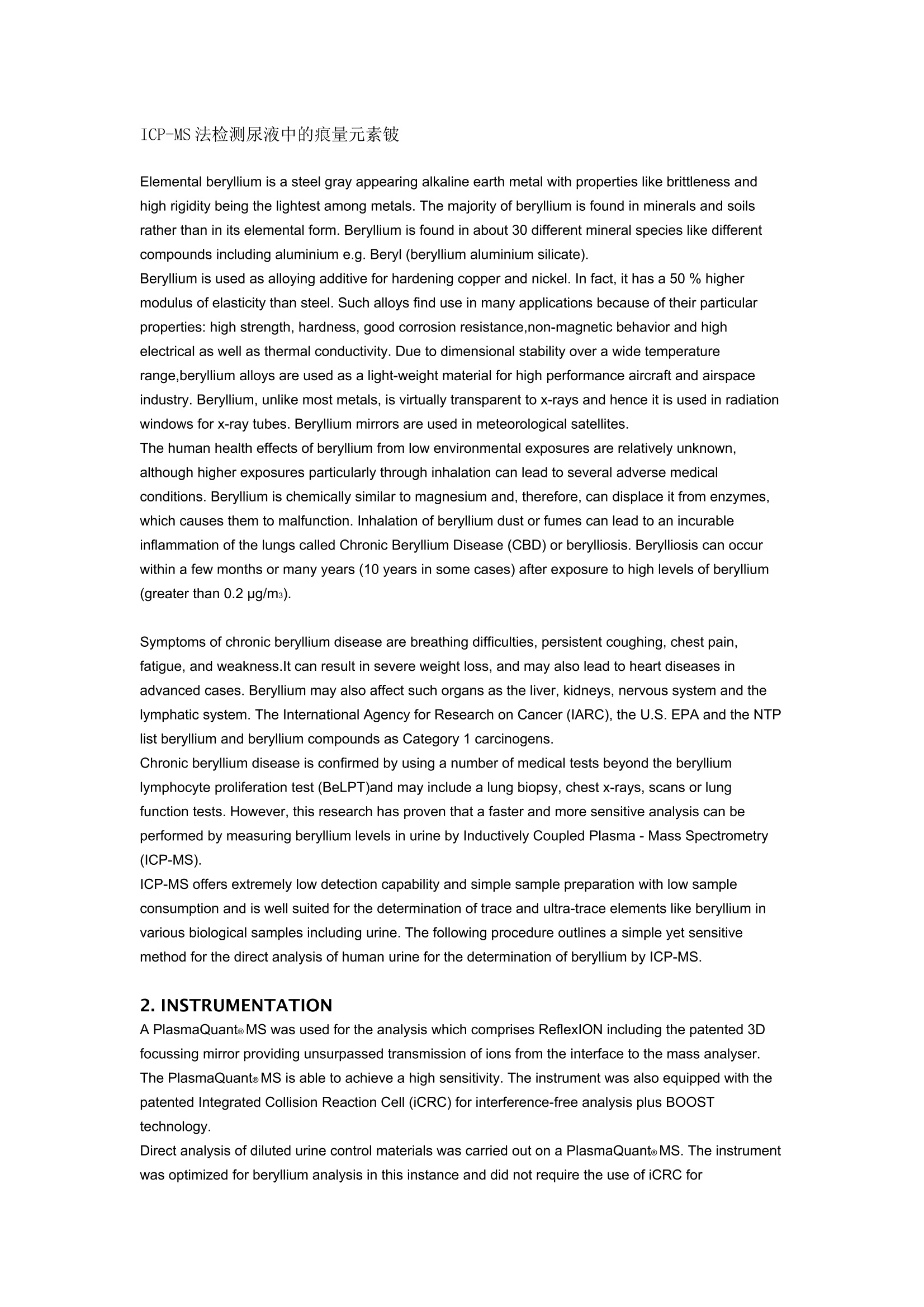
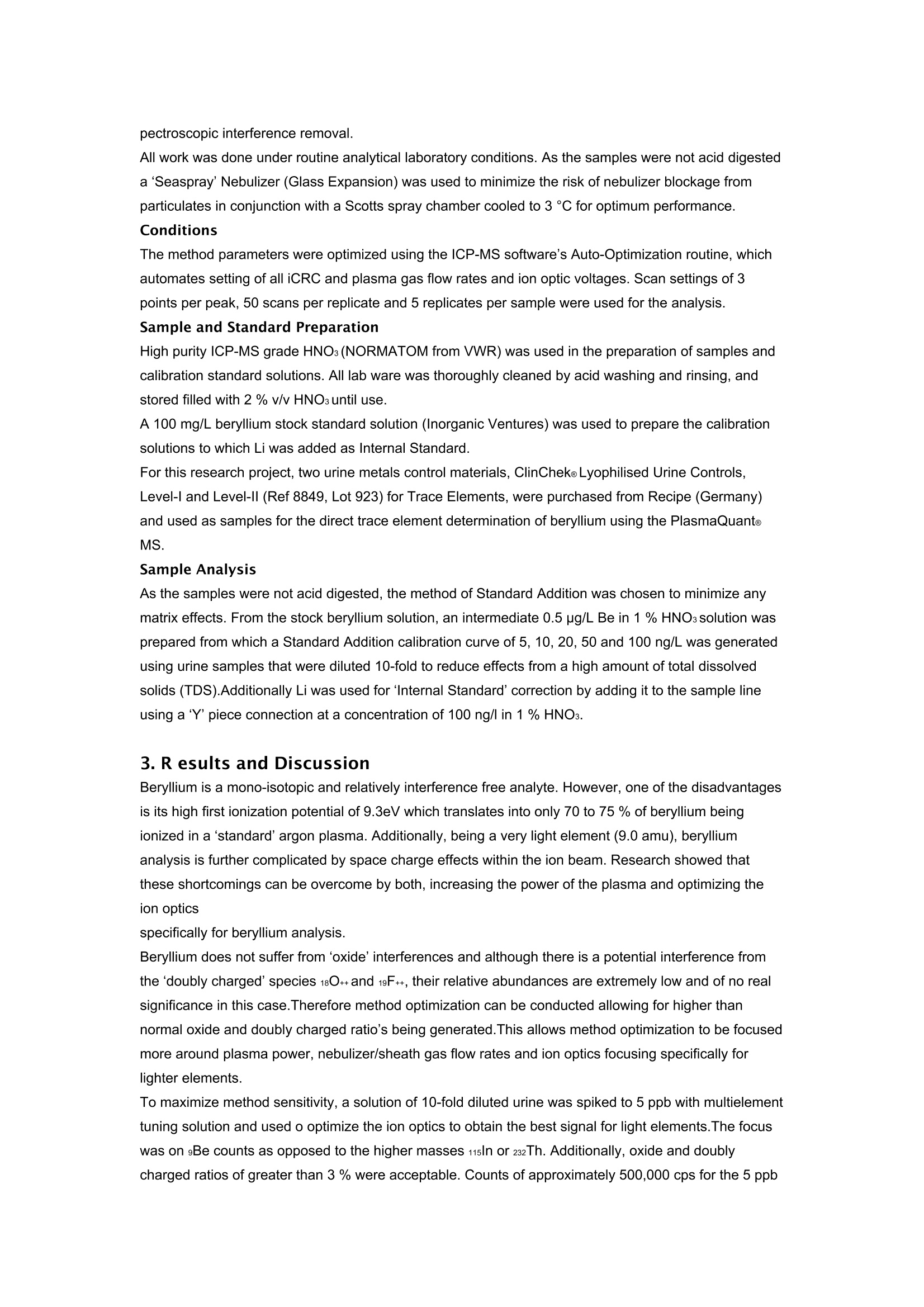
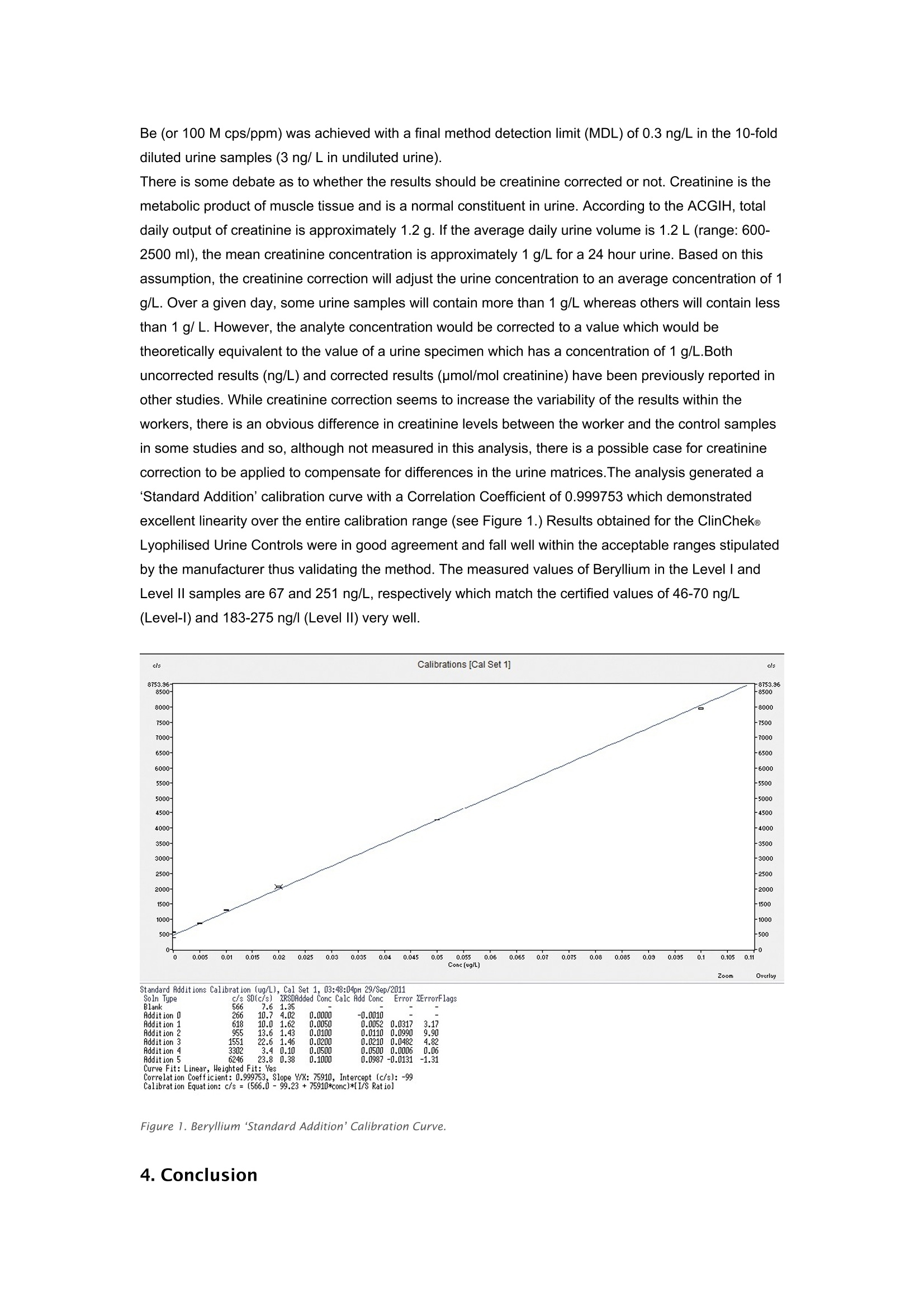

还剩2页未读,是否继续阅读?
耶拿分析仪器(北京)有限公司为您提供《尿液中痕量Be检测方案(等离子体质谱)》,该方案主要用于尿液中痕量Be检测,参考标准--,《尿液中痕量Be检测方案(等离子体质谱)》用到的仪器有德国耶拿PlasmaQuant MS 高灵敏度电感耦合等离子体质谱仪
推荐专场
相关方案
更多
该厂商其他方案
更多









